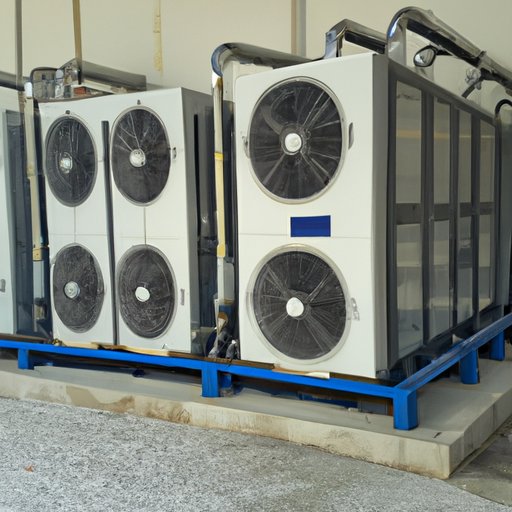Introduction: Overview of Refrigerant and How it Works
Refrigerant is a substance used in a variety of cooling and heating systems. It is used in air conditioners, refrigerators, freezers, and other appliances. It works by absorbing heat from the air inside the appliance and releasing it outside. This process is known as the refrigeration cycle.
The purpose of this article is to provide an overview of how refrigerant works and its various components. It will discuss the different types of refrigerants and their uses, explain the refrigeration cycle, describe refrigerant compressors and their components, discuss refrigerant piping and connections, explore safety considerations when working with refrigerants, and examine the impact of refrigerants on the environment.
Types of Refrigerants and Their Uses
There are many types of refrigerants available on the market today. The most common types are hydrofluorocarbons (HFCs), hydrochlorofluorocarbons (HCFCs), chlorofluorocarbons (CFCs), and hydrocarbons (HCs). Each type has its own set of advantages and disadvantages.
HFCs are non-ozone-depleting, but they have a high global warming potential. HCFCs are ozone-depleting, but they have a lower global warming potential than HFCs. CFCs are ozone-depleting and have a high global warming potential. HCs are non-ozone-depleting and have a low global warming potential.
The most common use of refrigerants is in air conditioning and refrigeration systems. They are also used in industrial processes such as cryogenics and for medical purposes such as cryosurgery. Refrigerants can also be used in automotive applications such as car air conditioners.
Understanding the Refrigeration Cycle
The refrigeration cycle is the process by which refrigerant absorbs heat from the air inside the appliance and releases it outside. This cycle consists of four stages: compression, condensation, expansion, and evaporation.
During the compression stage, the refrigerant is compressed in a compressor. This increases the pressure and temperature of the refrigerant, which causes it to absorb heat from the air inside the appliance. During the condensation stage, the refrigerant is condensed into a liquid form, releasing the heat it absorbed. During the expansion stage, the liquid refrigerant passes through an expansion valve, which reduces its pressure and temperature. This causes the refrigerant to evaporate, absorbing heat from the air inside the appliance. Finally, during the evaporation stage, the refrigerant evaporates, releasing the heat it absorbed outside the appliance.

Refrigerant Compressors and Their Components
A refrigerant compressor is the component of a refrigeration system that compresses the refrigerant. It consists of several components, including a motor, compressor, condenser, and evaporator. The motor drives the compressor, which compresses the refrigerant, raising its pressure and temperature. The condenser is used to cool the refrigerant, converting it into a liquid form. The evaporator then absorbs heat from the air inside the appliance, causing the refrigerant to evaporate.
Refrigerant Piping and Connections
Refrigerant piping is used to transport the refrigerant between the various components of the refrigeration system. There are two types of piping used: copper and plastic. Copper is the most common type of piping used because it is strong, durable, and resistant to corrosion. Plastic piping is lighter and cheaper than copper, but it is not as durable.
When connecting refrigerant piping, it is important to ensure that all connections are secure and leak-free. This is done by using sealing compounds and clamps to ensure a tight seal. It is also important to ensure that the piping is properly supported to prevent it from becoming damaged or disconnected.

Safety Considerations When Working with Refrigerants
Working with refrigerants can be dangerous if proper safety precautions are not taken. Refrigerants are toxic and flammable, so it is important to take the necessary precautions when handling them. This includes wearing protective clothing, such as gloves, goggles, and a respirator, and following the manufacturer’s instructions for safe handling.
It is also important to ensure that all equipment is properly installed and maintained. Leaks should be fixed immediately, and all connections should be checked regularly to ensure they are secure.

The Impact of Refrigerants on the Environment
Refrigerants have a significant impact on the environment. Many of the older refrigerants, such as CFCs and HCFCs, are ozone-depleting substances, meaning they contribute to the depletion of the ozone layer. They also have a high global warming potential, meaning they contribute to climate change.
To reduce the environmental impact of refrigerants, it is important to use efficient, low-emission refrigerants and to ensure that all equipment is properly maintained and serviced. Additionally, transitioning away from ozone-depleting refrigerants and towards more environmentally friendly alternatives, such as hydrocarbons, is essential.
Conclusion
Refrigerants are essential components of a variety of cooling and heating systems. Understanding how they work and the components of a refrigeration system is essential for ensuring the efficient and safe operation of these systems. Additionally, it is important to consider the environmental impact of refrigerants and to take steps to reduce emissions.
(Note: Is this article not meeting your expectations? Do you have knowledge or insights to share? Unlock new opportunities and expand your reach by joining our authors team. Click Registration to join us and share your expertise with our readers.)
